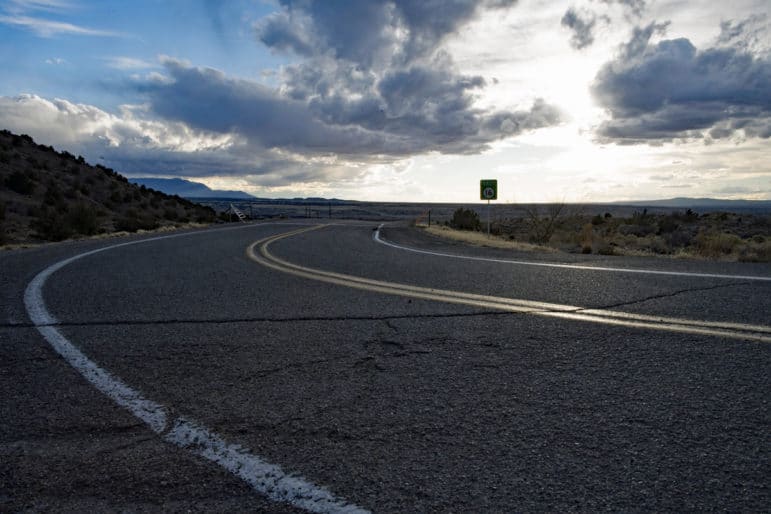
Don Usner / Searchlight New Mexico
One of the few well-paved roads on the Navajo Nation.
A few years ago, something rare showed up at the Teec Nos Pos Trading Post on the Navajo Nation: a big assortment of fresh fruits and vegetables.
Eighty miles south, spinach smoothies muscled their way into the Totsoh Trading Post, formerly ruled by foods like Cheetos and Twinkies.
The changeover was thanks to teamwork between store owners, Navajo health providers and the Gallup-based Community Outreach and Patient Empowerment (COPE), a nonprofit that supports health and wellness efforts across the Navajo Nation. The ongoing COPE “fruit and vegetable Rx” program helps remote stores bring in fresh produce, provides vouchers so families can afford it, and helps kids learn what nutritious food tastes like.
“There’s so much strength and inter-generational strength here,” says Sonya Shin, a medical doctor and COPE’s executive director. The needs are urgent: one in four adults has diabetes, she says. “But the solutions already lie within the community.”
Just six months of healthy eating can establish a health habit in young children.
“Kids are drivers of change,” she says.
But kids can’t drive change if their parents can’t drive the local roads to make it to the doctor or a food store — or if homes don’t have electricity. The Navajo Nation lacks more basic needs than almost any region in the country.
Among the problems:
Food
There are only about 10 full-service grocery stores on the entire reservation, according to the Diné Policy Institute.
For roughly 70 percent of communities — scattered across a region the size of West Virginia – there’s nothing nearby except a convenience store or trading post. Very few have affordable fresh produce.
Owing to severe poverty, the reservation has some of the country’s highest rates of food insecurity, the Urban Institute reports. Children go hungry and don’t know where the next meal is coming from.
Housing
More than a third of households across Indian Country are severely overcrowded or lack safe drinking water, an indoor toilet, electricity, heat, refrigerator, or other necessities for sanitation and health, according to the Department of Housing and Urban Development (HUD).
Housing conditions on the Navajo Nation are nearly the worst, outranked only by Alaska tribal housing, HUD concludes.
Rates of homelessness would be devastating if it weren’t for families opening up their homes to people with nowhere else to go, a generosity seen across Indian Country, HUD says. Nearly 100 percent of respondents in one HUD survey said a friend or extended family member lived in their household.
People who don’t double up sometimes end up sleeping in fields and ditches.
“That’s where I slept last night,” said a Navajo woman named Marilyn one February morning, pointing to a culvert near a Marriott hotel in Gallup. “I’m like a stray dog. I hope sometimes I won’t wake up.”
Each winter in Gallup, more than a dozen homeless people freeze to death in open fields. In 2014, three men were found dead of hypothermia in a single day.
Uranium
The Navajo Nation is home to 521 abandoned uranium mines, four abandoned mills and more than 1,100 uranium waste sites, the Environmental Protection Agency says.
The contamination is the legacy of corporations that from 1944 to 1986 mined nearly 30 million tons of uranium ore for the U.S. nuclear weapons program. The cleanup is decades and billions of dollars away from completion.
Uranium exposure is linked to high rates of cancer, kidney damage and diabetes. Uranium-contaminated water in unregulated wells is blamed for increased rates of birth defects, miscarriages and developmental delays.
Phones
In 2000, about 37 percent of households had landlines. The rest of the country had that level of phone service in 1920 — 80 years earlier, Federal Communications Commission legal filings show.
Today, about 75 percent of people have phone service, according to U.S. Census data; other estimates put the percentage lower. But there is no debate about the major problems with cell phone reception.
The Navajo Times reported that one Navajo term for cell phone is “hooghan bik bil dahjilwo” — or “a thing you use while running uphill,” describing someone in desperate search of a signal.
Searchlight New Mexico is a nonprofit nonpartisan organization dedicated to investigative journalism. Read more of our stories on Raising New Mexico at projects.searchlightnm.com.